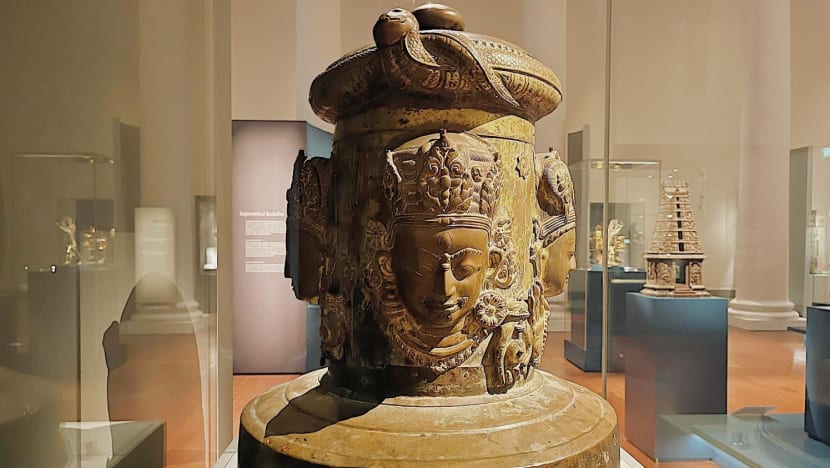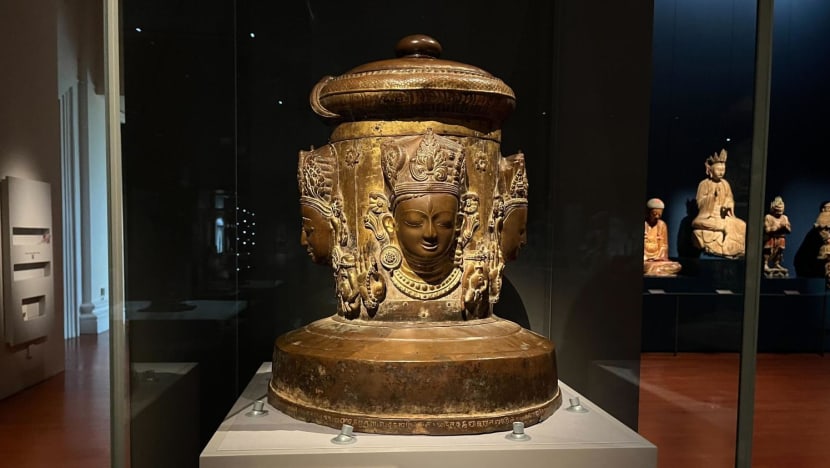Singapore museum says 400-year-old artefact allegedly stolen from Nepal was acquired by the book
The Asian Civilisations Museum was responding to reports of a 17th-century sculpture missing from Nepal since 1999 and now in its possession.

This 17th-century gold-copper icon from Nepal was acquired by the Asian Civilisations Museum in 2015 in accordance with established procedures, said the museum. (Photo: Shevaun Teo)
SINGAPORE: A nearly 400-year-old religious artefact allegedly stolen from Nepal and tracked down to Singapore recently was acquired in accordance with “established procedures” both local and international, said the museum where the piece is now on display.
On Sunday (Aug 14), an online initiative to recover lost artistic heritage from Nepal announced that a sculpture of a Hindu deity belonging to the Neel Barahi temple - dated 1636 and claimed as stolen in 1999 - had been “located in the collection of the Asian Civilisations Museum (ACM), Singapore”.
The post by the Lost Arts of Nepal Facebook page was picked up by multiple Nepalese media outlets which referred to the four-sided artefact as an “icon of great archaeological importance”.
An ACM spokesperson on Wednesday told CNA it was aware of the media reports.
“The object in the reports refers to a copper cover of a linga, which was acquired by ACM in 2015 in accordance with the National Heritage Board’s established procedures on acquisition,” he said.
“These procedures include evaluation by ACM’s acquisition committee made up of external experts, as well as rigorous provenance checks carried out at the time of purchase.”
These provenance – or ownership record – checks are also benchmarked against international practices and regularly reviewed, added the spokesperson.
“ACM further notes that the object is not listed in the Art Loss Register,” he said, referring to the world’s largest private database of looted art.
A linga is the phallic and cosmic pillar symbol of the Hindu god Shiva, according to a caption below the Neel Barahi exhibit, which CNA located in ACM’s Ancient Religions gallery on the second floor.

But the administrator of Lost Arts of Nepal - who requested to remain anonymous - told CNA that the 386-year-old artefact was instead used, along with six others, to represent shrines to mother goddesses in the Nepalese town of Pharping, some 20km south of capital Kathmandu.
The seven deities feature in an annual, centuries-old holy festival in Pharping but four of the original pieces have gone missing and have been replaced with replicas since.
The Neel Barahi sculpture, in particular, was stolen on the night of Jun 16, 1999, from the house of a caretaker who had been tasked to safe keep it for the year, said the person behind Lost Arts of Nepal.
“We don't know who stole it but the reason is (likely) increasing demand for Nepalese art and huge financial gains,” the activist added.
The campaigning group said the Neel Barahi would have travelled through various hands before reaching the ACM in Singapore, though its history of ownership is unclear.

In 2019, Lost Arts of Nepal first got wind of the Neel Barahi being in ACM’s collection and subsequently spotted the artefact in the background of a photo of another exhibit.
The group told CNA it has raised the matter to the Nepal Heritage Recovery Campaign, an organisation also working to restitute stolen heritage pieces from the country.
The Nepal Heritage Recovery Campaign will in turn work with the Department of Archaeology within the Nepal government to communicate with Singapore’s ACM “via diplomatic channels”.
CNA has contacted the department and Nepal's Ministry of Culture, Tourism and Civil Aviation for comment.
“We are convinced that we can prove the stolen deity belongs to the community of Pharping,” said Lost Arts of Nepal.
“It's not just a piece of art displayed in a museum gallery; it's our ancestors, our guardians, our faith.”
In 2015, the ACM returned to Indian authorities an 11th-century bronze sculpture believed to have been illegally removed from the country.
ACM had purchased the sculpture - depicting a Hindu goddess - in 2007 for US$650,000 (S$896,400) from a defunct New York gallery accused of an extensive antiquities-smuggling operation.














